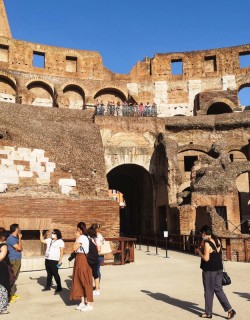Made famous by countless movies, books and images, the Trevi Fountain is right up there alongside the Colosseum as Rome’s most recognizable landmark. It’s the most spectacular piece of Baroque city design in the Eternal City, and arguably anywhere in the world: a massive (it’s almost 50 meters wide and over 26 meters high) and theatrical display of marble sculptures and rushing water that's a must-visit when in Rome.
Just arriving at the 17th-century monument is thrilling: the fountain is hidden amongst the narrow higgledy-piggledy lanes of Rome’s historic center, and you can hear it long before you can see it - raising anticipation even further. When you finally turn the last corner and the small Piazza di Trevi opens before you to reveal the fountain in all its over-the-top glory, you can’t help but be amazed - at the beauty, at the noise, and, less thrillingly, the crowds.
Nonetheless, this is one place that crowds can’t dampen my enthusiasm for. Despite having lived in Rome for decades, every time I pass the Trevi Fountain, I’m filled with a sense of wonder.
A Short History of the Trevi Fountain

The incredible scale and grandeur of ancient Rome was due, in large part, to the empire’s command of water. Without the vast quantities of fresh water that flowed into the city from the surrounding countryside via a series of high-tech aqueducts, antiquity’s greatest city would have remained a provincial backwater.
One of the most important of the ancient aqueducts was the so-called Aqua Virgo, constructed in 19 B.C. under the direction of the influential Marcus Vipsanius Agrippa. This aqueduct was principally designed to supply water to Agrippa’s bath complex, but also provided drinking water to a large area of the city. Following the fall of the Roman Empire, the Aqua Virgo suffered damage from invading Gothic troops, leading to a significant reduction in its capacity.
With the return of the popes to Rome in the 15th century, the city finally reversed more than a millennium of decline; ancient aqueducts were restored and new water supplies were directed towards Rome. In 1453, the renowned architect Leon Battista Alberti played a key role in renovating the Aqua Virgo. A modest fountain was constructed at the aqueduct’s new terminus, which came to be known as the Trevi Fountain due to its location at the intersection of three ancient roads, or trivium (three roads).
In the 1730s, Pope Clement XII commissioned the Roman architect Nicola Salvi to create a Baroque monument worthy of the newly rechristened Acqua Vergine. Salvi's design resulted in the spectacular Trevi Fountain we see today, a testament to Rome’s enduring connection to its historic water sources.
What’s the Symbolism of the Trevi fountain?

Appropriately enough, the overarching theme of the complex of sculptures decorating the Trevi fountain is the power of water and its crucial role in sustaining life. Framed in a niche at the center of the fountain is the figure of the sea-titan Oceanus, who controls the flow of the rushing waters with a commanding gesture from his shell-chariot. Beneath him two winged hippocampi, creatures who are half horse and half fish, are being tamed by tritons - symbolizing the god’s power to still the wild waters of the sea.
To either side of Oceanus are classicising personifications representing health and abundance, whilst four figures portraying the life-giving properties of water line up at the top of the fountain. Look out too for four bas-reliefs that recount the history of the Trevi. Surmounting everything, meanwhile, is the Papal coat of arms of Clement XII.
What’s the Building Behind the Fountain?
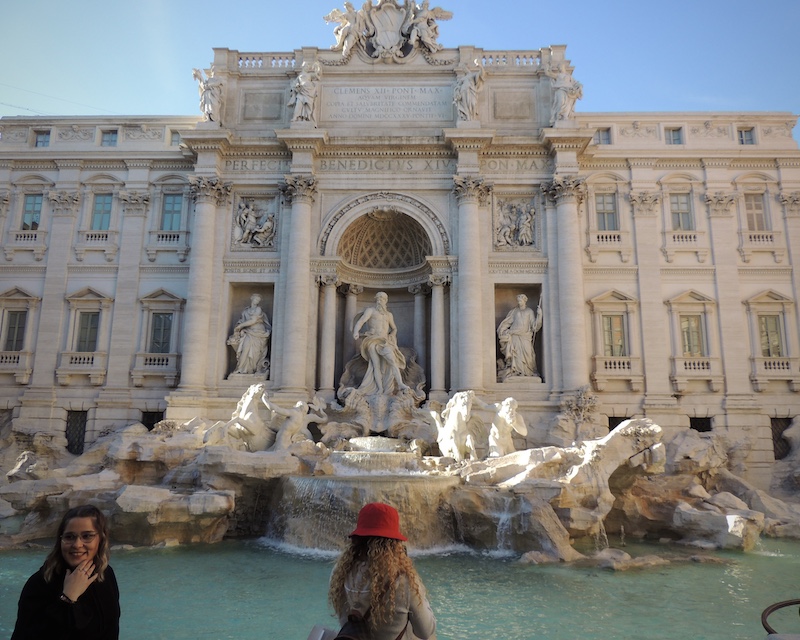
One of the most distinctive features of the Trevi Fountain is that it’s built right into the facade of a building. This is the Palazzo Poli, a sumptuous 16th-century residence that received a massive expansion in the 1720s at the behest of owner Giuseppe Lotario Conti, Duke of Poli.
When Salvi was commissioned to create the Trevi fountain nearby, the palace was in the way. And so he came up with the ingenious solution of incorporating the fountain into the rear facade of the Palazzo Poli.
Today it houses the Central Institute for Graphics, and boasts extraordinary views of the Trevi Fountain from the large Sala Dante within.
How Do I Get To The Trevi Fountain?
The Trevi Fountain is located right in the heart of the historic center of Rome, and is within easy walking distance of many of the city’s other most important landmarks - the Spanish Steps, Piazza Navona and the Pantheon are all under 10 minutes walk from here. The nearest metro station is Barberini - Fontana di Trevi, and is about a 10 minute walk away. Many city buses stop at Largo Chigi, just a short walk away from the fountain.
What is the best time to visit the Trevi Fountain?

As the saying doesn’t quite go, three things are unavoidable in life: death, taxes and crowds thronging the Trevi fountain. But whilst it can seem like there’s a teeming mass of humanity crowding the narrow steps around the Trevi fountain taking photographs, slurping ice-creams and lobbing coins at all times of day and night, if you’re smart you can plan your visit to avoid the worst of the crowds.
If you want to see the Trevi at its glorious best, then you’re going to have to visit at some pretty unsociable times. Gazing on the fountain at dawn, just as the sun comes up, is an unforgettable experience. While the square won't be deserted, you won’t have to jostle too hard for a front-row view - there’s barely anyone here at this time.
Alternatively, the Trevi fountain is almost indescribably romantic in the dead of night, long after almost everyone else has gone to bed. This is when Anita Ekberg makes her iconic impromptu plunge in La Dolce Vita - follow in her footsteps to arrive at the fountain in the small hours, but resist the urge to take a dip - a hefty fine awaits.
If losing out on sleep isn’t your idea of a relaxing holiday, then another great time to visit the Trevi Fountain is at sunset. Sure there will be plenty of people around, but the light at this time of day bathes the Trevi in a magical glow. This is the time of day that we visit the Trevi Fountain on our Rome at Twilight walking tour - more on that below.
Can I Take a Tour That Includes the Trevi Fountain?
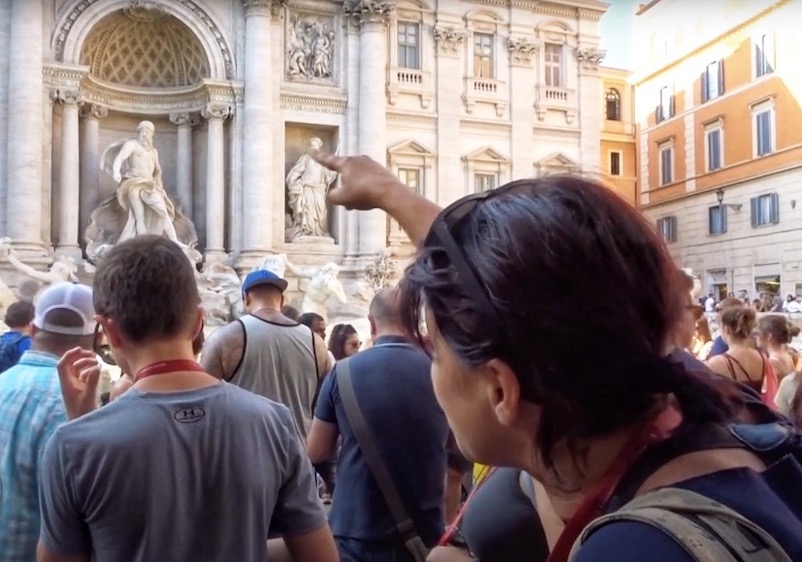
Through Eternity’s Rome at Twilight tour is a small group walking itinerary that visits the most important landmarks of the city’s historic center, and is the perfect introduction to the Eternal City. We’ll visit the Pantheon and Piazza Navona, the Spanish Steps, Trevi fountain and more on a beautiful route that will introduce you to the sights and sounds of one of the world’s most beautiful cities. This itinerary is also available as a private tour. Click the button below to learn more and book your place!
What is the Coin Toss Tradition at the Trevi Fountain?

Almost every visitor to Rome knows that according to legend, if you throw a coin into the fountain’s waters you’ll be sure one day to return to Rome. But did you know that there is a specific technique you have to adopt for the wish to come true?
The right way to do it is as follows: hold a coin in your right hand, with your back to the fountain, and throw it over your left shoulder. A further embellishment of the superstition holds that if you lob two coins in you’ll not only guarantee another visit to Rome, but you’ll also fall in love as well.
The myth was popularized by the 1950s Hollywood film Three Coins in the Fountain, but actually has more distant origins: burying coins in wells and fountains was an ancient practice, and the tradition of throwing coins into the Trevi was first suggested by a German antiquarian called Wolfgang Helbig in the 19th century.
What happens to the coins tossed into the Trevi fountain?
Each year millions of euros worth of coins are thrown into the Trevi fountain by bright-eyed visitors seeking to guarantee their return visit. In the past a motley cast of characters often made off with the spoils, including one local who extracted the coins from the fountain with a sword-shaped magnet. These days any attempts to fish out the money is strictly illegal, and the municipal authorities collect the coins once per week to donate to Caritas, a local homeless charity.
Where to Eat Around the Trevi Fountain
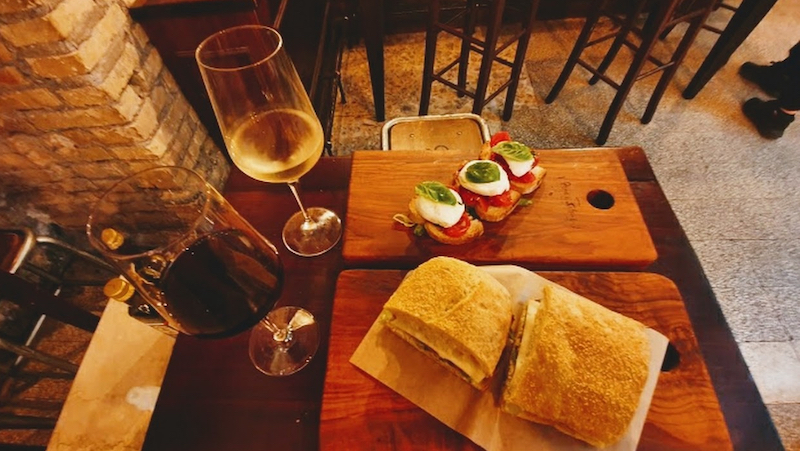
The Trevi Fountain is located in one of the most touristy areas of Rome, and that means that there are unfortunately a lot of tourist-trap restaurants and bars around here. But if you do find yourself in need of a bite to eat, never fear - there are some good options. You just need to know where to go! Here are some recommendations.
Bar San Marcello
Via di San Marcello, 38

It can be hard to find authentic bars “come una volta” (like they used to be) in this area of Rome where few locals live, but Bar Marcello is a lovely exception. Don’t expect anything fancy - just good coffee, panini and simple pasta dishes and salads during the lunch hour, served up to hungry office workers at locals-friendly prices.
Pane e Salame
Via Santa Maria in Via, 19

Maybe our favorite sandwich joint in downtown Rome, Pane e Salame is a classic go-to destination for a quick lunch in this part of town. Heaving platters of meats and cheeses, generous sandwiches and a good selection of wines by the glass and bottle make for a welcome pit-stop after battling the crowds at the Trevi.
Prosciutteria Cantina dei Papi
Via della Panetteria, 34A
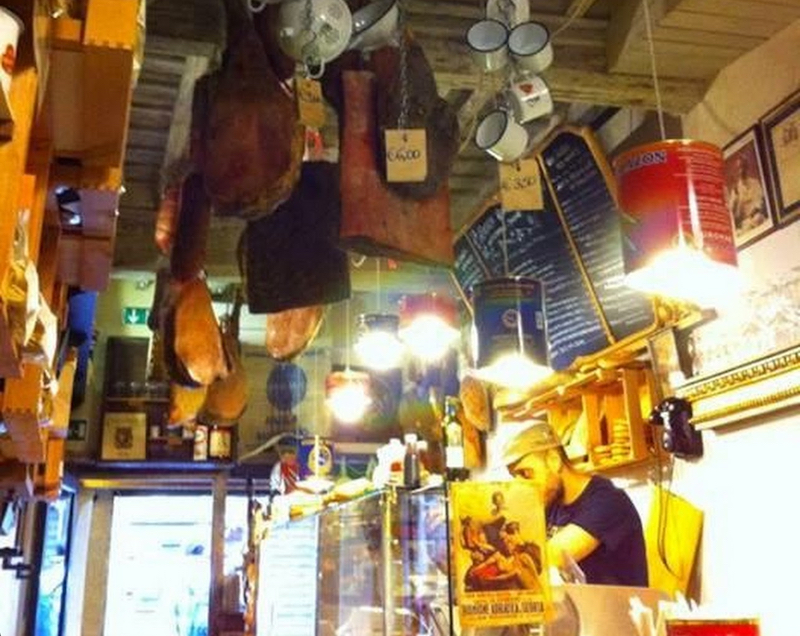
Sausages and salamis hang from the rafters of this atmospheric little spot serving up antipasti boards and panini alongside good wine just steps from the Trevi. Whatever you choose is going to hit the spot, but the porchetta here is particularly fine.
Il Piccolo Arancio
Vicolo Scanderbeg, 112

A reliable and long-standing address in this part of town, Il Piccolo Arancio is popular with the professional set working in the nearby Quirinale area, and is about as far away from a tourist trap as you can get. Go-to dishes include the “ravioli all’arancia”, the fettuccine with lamb ragù and the superb homemade “surf and turf” pasta with fresh porcini mushrooms and clams.
MORE GREAT CONTENT FROM THE BLOG:
- How to Visit the Pantheon in Rome
- 9 Things You Need to Know About the Pantheon in Rome
- Who is Buried in the Pantheon?
- The Best New Tours of Italy in 2024
- How to Visit the Colosseum in 2024
- Where to Stay in Rome in 2024: Areas and Hotels Guide
For over 20 years, Through Eternity have been organizing itineraries showcasing the best of Rome led by our resident expert guides. If you're planning a visit to the Eternal City this Spring, be sure to get in touch to help plan your perfect trip!



